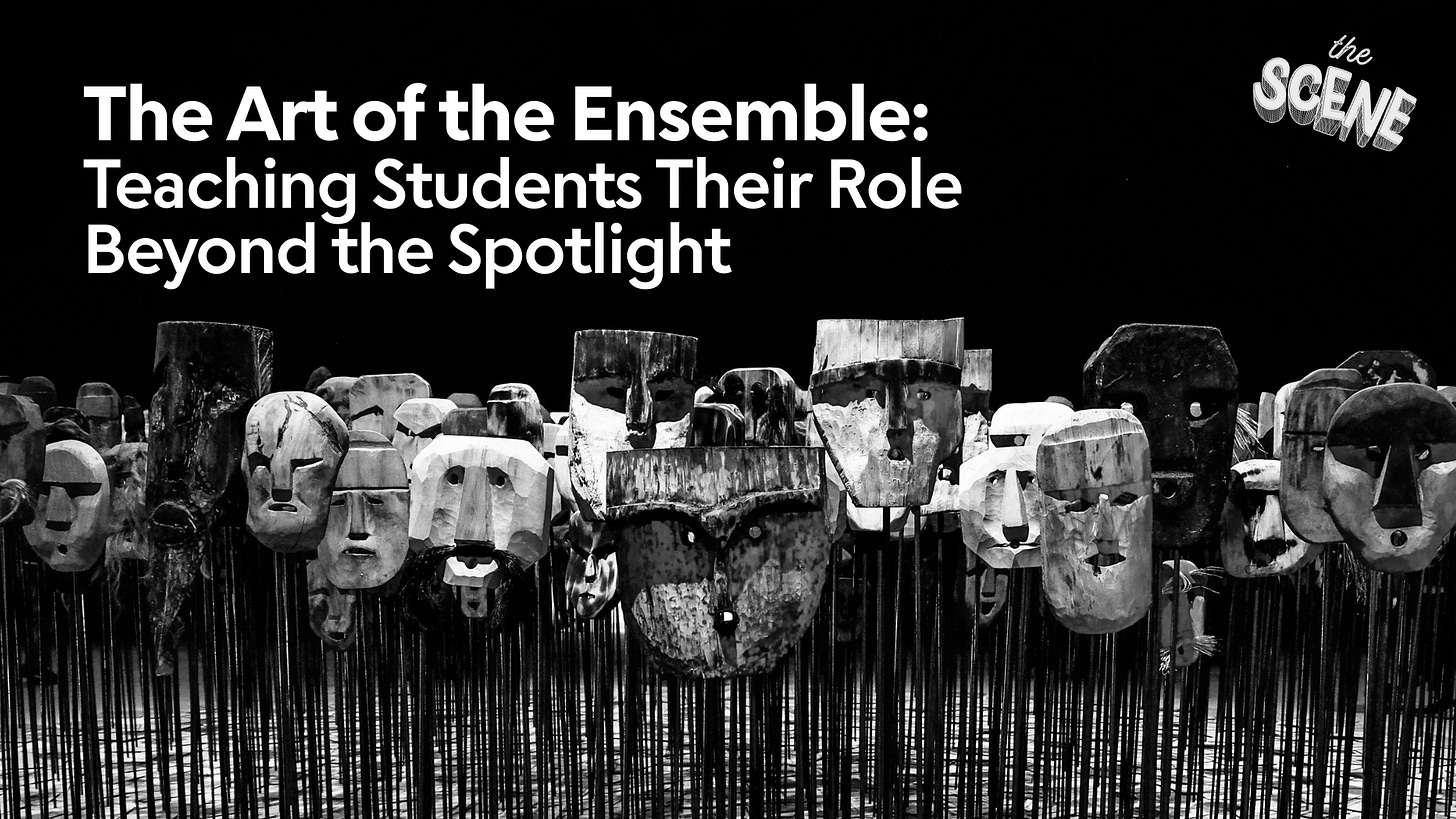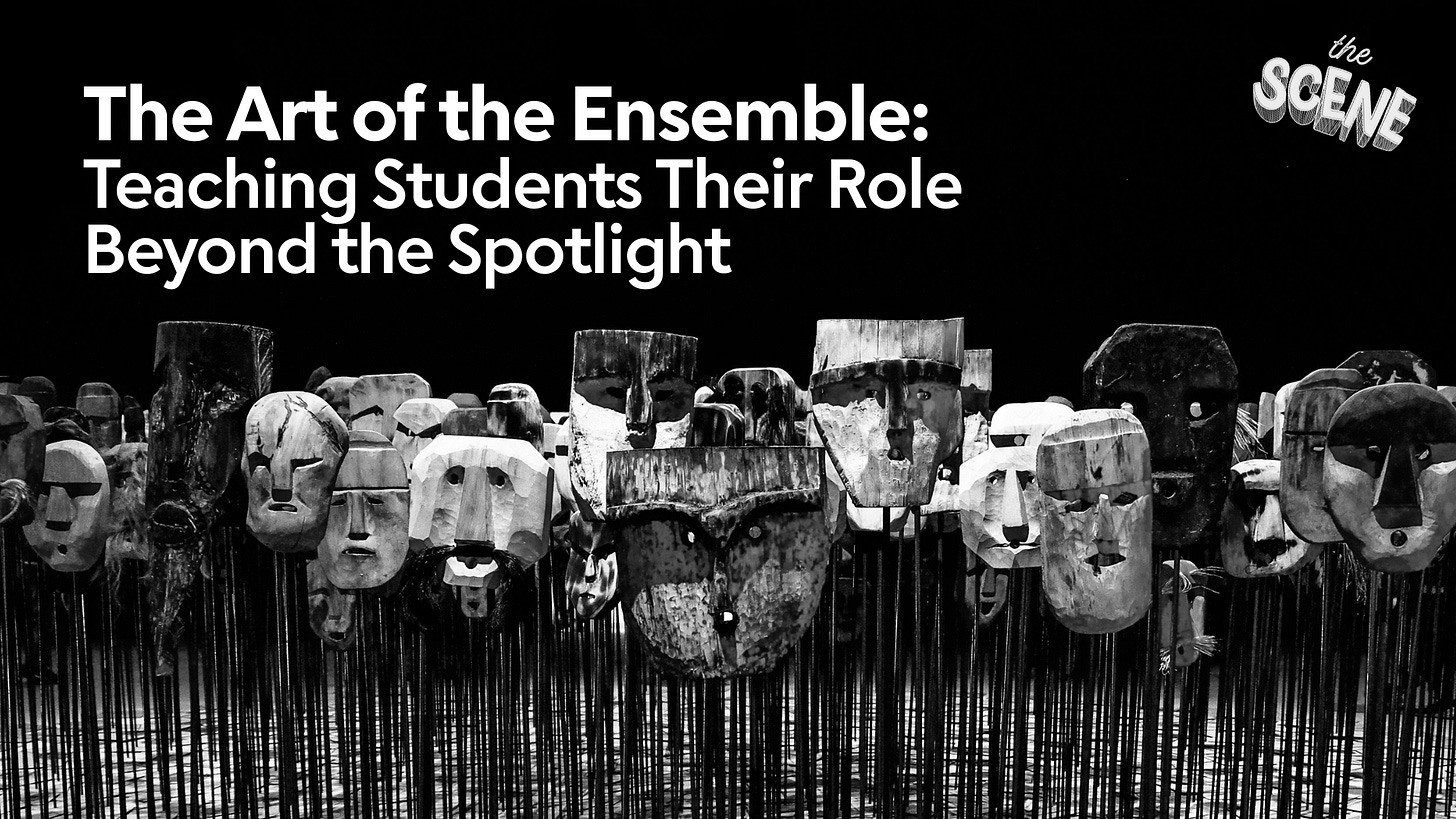The Art of the Ensemble: Teaching Students Their Role Beyond the Spotlight
Plus, your weekly round-up of theatre news you may have missed!
Welcome to The Scene, your weekly round-up of theatre news you may have missed.
Also in this week's edition,
We explore The Art of the Ensemble: Teaching Students Their Role Beyond the Spotlight. Theatre isn’t about one star at center stage, it’s about the collective heartbeat of the company. Discover practical ways to help every student feel vital to the story, build ownership, and transform the ensemble from background to backbone.
And don’t miss this week’s free read from Playscripts: Return to Seymour Street by Tom Dudzick.
So, raise the curtain and shine the spotlight as we dive into another thrilling week in the theatre world. Welcome to The Scene.
Dates Revealed for Kelli O’Hara, Rocky Horror, Rose Byrne, More in Roundabout’s 2026 Broadway Season by Margaret Hall, Playbill | Roundabout will renovate the recently renamed Todd Haimes Theatre for much of the season before reopening the venue in spring 2026. Read...
Schmigadoon! Is Coming to Broadway in 2026 by Logan Culwell-Block, Playbill | The television series-turned-stage musical made its world premiere at the Kennedy Center earlier this year. Read...
Stephen Adly Guirgis’ Dog Day Afternoon Finds a Broadway Home by Meg Masseron, Playbill | Olivier winner Rupert Goold will direct the play, telling the true crime story that inspired the 1975 Oscar-winning film. Read...
Keanu Reeves and Alex Winter on “Waiting for Godot“ | by Tracy Smith, CBS Sunday Morning. Watch Below.
Listen to the ‘Ragtime’: Broadway revival will be preserved on new cast album by Beth Stevens, Broadway.com | The company heads into the studio next month, with the recording produced by Sean Patrick Flahaven along with creators Lynn Ahrens and Stephen Flaherty. Read…
How John Leguizamo Spends a Day Before Taking the Stage by Sarah Bahr, The New York Times | The actor fits in tennis with his son, a writing session and lots of dancing before performing his new show at the Public Theater. Read...
Ryan Spahn’s Inspired By True Events Joins Concord Theatricals Licensing Catalogue by Logan Culwell-Block, Playbill | The work, set at a Rochester community theatre, made its world premiere Off-Broadway via Out of the Box Theatrics last year. Read...
He’ll Have the 10-Hour Theater Show, Please by Laura Cappelle, The New York Times | As director of Odéon-Théâtre de l’Europe, one of France’s top playhouses, Julien Gosselin is facing strong budgetary headwinds. But he’s keeping his vision big. Read...
The Big Idea
The Art of the Ensemble: Teaching Students Their Role Beyond the Spotlight
by Zach Dulli, The Scene
Let’s set the record straight: theatre is a team sport. Always has been. Always will be. Sure, audiences may remember the lead who belts out the eleven o’clock number, but if the ensemble isn’t firing on all cylinders, the whole production feels like it’s running on a flat tire. The trick is to help every student, whether they’re standing center stage with a solo or in the back corner playing “Tree Number Four,” understand that their work is vital to the storytelling.
Theatre is an orchestra of voices, bodies, and energy working in harmony that creates the story. Strip away the ensemble and the play collapses into a hollow monologue. The ensemble is the landscape, the rhythm and the pulse of productions. Yet, too often, young performers think their value comes from the size of their role. That thinking reduces theatre to arithmetic: more lines equal more importance. In reality, the measure of importance lies in contribution. And contribution is everywhere.
To drive the point home, ask students to picture a painting. The figure in the foreground may catch the eye, but without the colors of the sky, the shadows in the corner, and the brushstrokes that fill the canvas, the image is incomplete. Take away the background, and the subject floats in nothingness. Theatre works the same way.
Building Awareness
Start by letting students see that absence. Have the leading roles play a scene without the ensemble. Let it hang in the air like an unfinished sentence. Then run it again with the full company. The difference is undeniable: suddenly the story has gravity, momentum and context. What seemed like filler is revealed as structure.
Another exercise to help drive home this point is to divide the ensemble into small groups and ask them to sketch relationships that exist beneath the text. Who knows whom, who disagrees, who shares history? These unspoken connections transform a crowd into a community. Suddenly, they’re no longer “background.” They’re a world.
And for a touch of fun, drop the cast into improvisation. Assign a situation, such as celebrating, panicking, waiting or mourning, and observe how it generates atmosphere. It doesn’t matter that none of it is in the script. What matters is the realization that they can carry the emotional weather of a scene.
Ownership and Responsibility
The great secret of theatre is that audiences rarely follow one character. They follow energy. And the ensemble is the engine of that energy. When students understand they control tempo, tone and atmosphere, the room shifts. They stop waiting for permission and start claiming responsibility.
One way to do this is to give your ensemble members authority over the atmosphere of a scene. Identify and assign moments where they know their presence drives the energy, mood or pacing. When they understand that they set the emotional temperature, the work becomes theirs in a new way.
It also changes the way “leadership” looks. Leadership isn’t holding the most lines. It’s recognizing when the collective needs to lean in, hold back or drive forward. A true ensemble distributes that responsibility across the stage.
Rotate leadership, too. Let ensemble members lead warm-ups, guide a group exercise, or decide how the community on stage should react to a turning point. When students feel their choices shape the production, they stop thinking of themselves as “just in the background” and start stepping into the role of artists.
A Word to the Leads
This isn’t just about ensemble pride. Your leads need to understand their success is tethered to the ensemble. Encourage them to express gratitude, recognize their importance, and foster camaraderie. Remind them that curtain calls are not a hierarchy, but a gesture of appreciation for the collective effort.
Why It Matters
This lesson travels far beyond rehearsal. Most of life is lived in ensembles. Offices, classrooms, teams and communities are all ensembles. Learning to be vital even when you’re not the center of attention is one of the most valuable skills theatre can teach.
So, here’s the charge: erase the idea of “supporting roles.” There are no small parts, no background, no filler. There is only the company, the story, and the responsibility of every member to tell it fully. Theatre is not a solo. Theatre is a chorus. And when students believe that, they don’t just put on a stronger show. They step into the world ready to play their part.
Oh, Mary! Is London-Bound; Mason Alexander Park Will Star by Logan Culwell-Block, Playbill | 2025 Tony winner Sam Pinkleton will be back to direct Cole Escola’s wacky comedy. Read...
Full cast revealed for Sherlock Holmes comedy with songs by Andrew Lloyd Webber and Tim Rice by Alex Wood, WhatsOnStage | The play will run at the Birmingham Rep – now see who’s involved! Read...
Wicked Mass Singalong to Be Held in London. Schools Worldwide Encouraged to Participate by Margaret Hall, Playbill | The event will be streamed live from London’s O2 Arena. Read...
John Malkovich Joins London Hunger Games Stage Play by Logan Culwell-Block, Playbill | The screen star will play President Snow in a filmed appearance. Read...
Carmen Cusack and Nik Walker-Led Bull Durham Begins at the Paper Mill by Andrew Gans and Diep Tran, Playbill | The new musical adaptation of the 1988 film is directed by Marc Bruni. Read...
New Works from Tom Kitt, Adam Rapp, More Revealed for Eugene O’Neill Theater Center’s Fall Development Schedule by Meg Masseron, Playbill | The Connecticut theatre institution will host a number of residencies supporting new work. Read...
Sara Gettelfinger to Lead Cast of The Cher Show at North Shore Music Theatre by Linda Buchwald, TheatreMania | Charissa Hogeland and Madeline Hudelson also star. Read...
Programming Revealed for 4th Annual Breaking the Binary Theatre Festival by Margaret Hall, Playbill | The festival will continue the company’s mission of producing work created and developed by transgender, non-binary, and Two-Spirit+ (TNB2S+) theatre artists. Read...
Free Reads of the Week
Read entire plays for free! Playscripts offers a selection of full-length and one-act plays that you can access for free, which is ideal for use in theatre productions, school performances, or competitions. To explore these titles, click on the cover image below or select the "READ FOR FREE" button at the bottom of this section. This action will direct you to the play's page on the Playscripts website. Once there, click "READ NOW" to begin enjoying the play immediately!
Return to Seymour Street by Tom Dudzick
The Story: Childhood sweethearts Peter and Irene have found each other again after more than twenty years apart. After Irene shows up to an event promoting Peter’s latest book on paranormal experiences, Peter offers his childhood home to Irene for the home-renovation TV show she is producing. Irene brings her teenage son, Gary, with her in the hopes that Peter might be able to help Gary with the strange, possibly supernatural communications he has been receiving. As Peter and Irene’s romance slowly rekindles, they find themselves up against the house’s angry tenant, the ghost of Peter’s dead father—and he wants them OUT! Frightening ghostly confrontations, wild psychokinetic activity, and the unearthing of long-dead secrets all lead to a hair-raising showdown to see who can take possession of the family homestead.
Genre: Mystery Thriller | Run-Time: 90-110 minutes | Casting: 1 W, 2 M, 3 Any (1-3 actors possible: 1-3 W, 1-3 M) | Set: Living room of an old, empty house.











